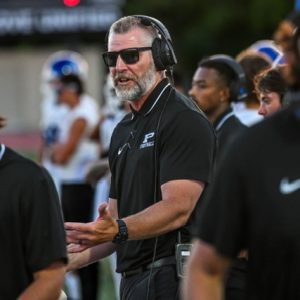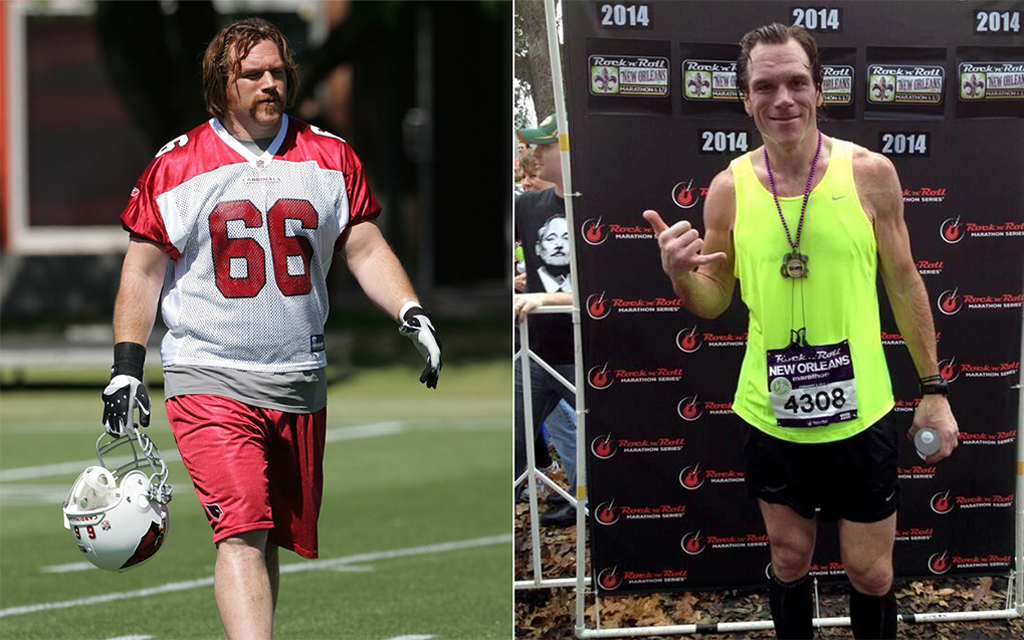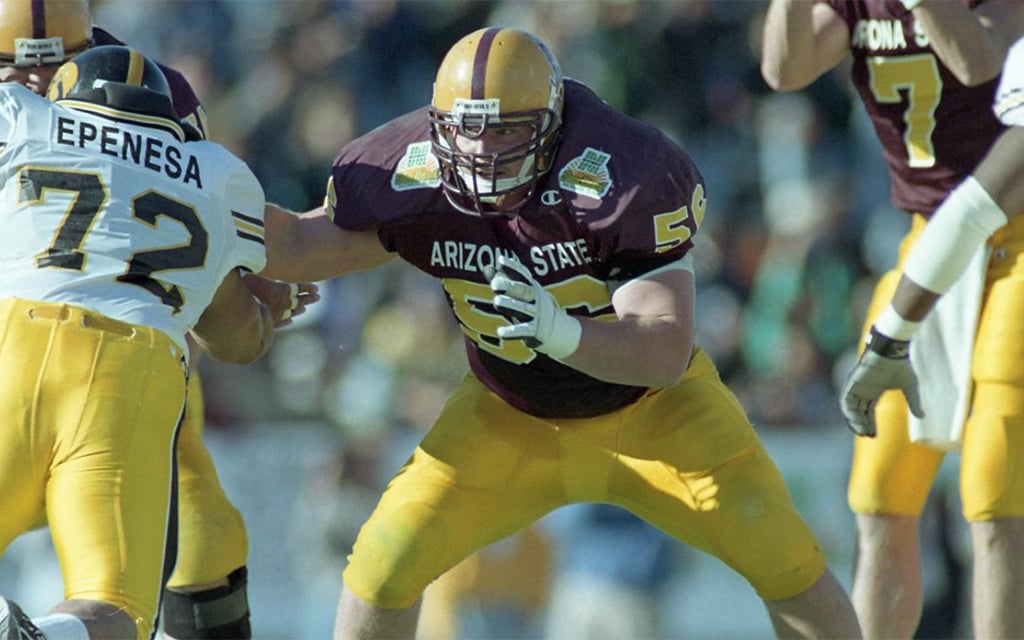The impact of an unbalanced relationship with food
It took quite some time for Murphy to realize how his changed relationship with food was affecting him.
While he was an athlete, he never really thought about the way he looked at food.
“For me, it’s something I didn’t realize probably until much later in life,” Murphy said. “When you’re in it, it’s about surviving so that you can play. Everything is about retaining your starting position if you have it, or getting it if you don’t, and then keeping it. So… it’s like lifting, watching film, getting treatment. It’s part of the process for you to play.

Former ASU offensive lineman Kyle Murphy, now the head coach at Pacifica High School in California, said the process of changing his relationship with food has been a gradual and methodical one. (Photo courtesy of Kyle Murphy)
“I didn’t think of it as much as a chore then as when I got older and understood that my relationship with food wasn’t great because I didn’t have great habits. I wasn’t taught those things.
“It really was about consuming calories. It’s different now; there’s nutrition, dietitians and all of that within these big programs. For us, it was just about (getting) your calories in. Nobody was telling us, ‘Here’s what you should be eating. Here’s what you shouldn’t be eating.’ It was, ‘Eat. Get to be 300. You guys got to get to 300 pounds.’”
In 2022, Murphy began to reexamine his relationship with food as a whole. He didn’t like the way he felt.
“Part of it is my personality,” Murphy said. “I’m an all-or-nothing kind of guy sometimes for most of my life. So I can go to either extreme. At the beginning of losing weight, I wouldn’t have anything. Wouldn’t have ice cream, wouldn’t have anything that I deemed that was outside of what would get me to my goal. Over this last year and a half, I’ve also realized that I can have an ice cream and that doesn’t ruin what I’ve done, as long as it’s a one-time thing or it’s every now and then.”
The process of reorienting his relationship with food has been a gradual and methodical one.
Now, it’s in a much better spot.
“I would say that my relationship with food has improved because I better understand its purpose, how to use it, what works for me while also recognizing that if I go out and have In-N-Out, that doesn’t make me a terrible person and I’m not breaking what I established,” Murphy said. “That was probably the biggest thing – I didn’t diet. Over the last year and a half, it’s not a diet; it’s not keto; it’s not fasting. I changed my habits very slowly.”
Armed with his new approach to food, Murphy is trying to apply what he has learned as he gets set to take on the role of head football coach at Pacifica High School in Garden Grove, California.
Hired in March, Murphy hopes to use his story as a cautionary tale for his players.
“It’s been part of the process for me to take the head coaching job because now I can share that stuff with the kids and make sure that we’re talking to them about their nutrition and what’s important, letting our offensive linemen know that you don’t have to be 300 pounds to be successful, that we want you to be able to move and be athletic,” Murphy said. “That’s the most important piece, along with (the players) then getting in the weight room.
“Ultimately, it’s about understanding balance in your life. Everything is about balance. If you want to go out and have a couple double cheeseburgers, no problem – understanding that if you do that every day, then that’s going to be problematic. You do that every once in a while, it’s not that big of a deal.
“Being able to pass that onto our athletes makes that relationship with food that much better.”
With society becoming more open on topics such as mental health and the improvements in sports nutrition, Murphy is optimistic about the future.
Hope for the future ahead
There was one particular moment that changed Murphy’s outlook as he struggled with his nutritional habits.
“My trainer really made me rethink something,” Murphy said. “When you are on a diet and you go somewhere and somebody asks you, ‘Hey, do you want this?,’ and you’re like, ‘No thanks. I’m not eating that right now.’ There’s this tendency where they go, ‘Oh, why not?’ because they feel as if you are denying yourself. What he told me was, if you approach it this way: ‘I don’t have to do this. I’m choosing to do this. This is my choice.’ You’re now taking control over your decision-making and the food.
“The food becomes less powerful over you. It really shifted my mindset about how I look at things. These are choices that I’m making, that these aren’t things I’m denying myself. These are things I’m choosing to not have. So it gives me the power as opposed to the food the power.”
In his new role at Pacifica High in Garden Grove, Murphy wants to emphasize that the 300-pound number is a remnant of the past. He wants his players to know that it also matters how one gains weight.
It’s especially important to Murphy, considering his personal history.
“It starts in high school,” Murphy said. “So often, I think high school kids feel they have to be this certain weight and size to be able to play college football. Not enough people are teaching them how to do that properly. That’s where I see the biggest concern.
“Colleges have that well taken care of with their dietitians, nutritionists. High school is where it becomes problematic. They see the size of offensive linemen in college and they feel they have to be at this particular weight.
“I mean, 300 was the threshold when I was in college. It’s not quite the same. I still think it’s problematic because if you see the size of offensive linemen when they come in (and) a lot of them are still sloppy. They’re not well put together – they’re heavy, but they’re not put well enough together because it just hasn’t been taught how to get there.”
Murphy hopes that changes, and there is evidence that it is changing.
Current ASU offensive lineman Joey Ramos, who grew up in Arizona and played at Deer Valley High School in Glendale, is an example of how the times have changed.
Ramos stands at 6-foot-5 and weighs 315 pounds at the moment. Like Murphy, he was always the biggest kid whenever he played sports, which led him to the offensive line.
But, unlike Murphy, the goal wasn’t to reach 300 pounds by any means. Ramos wasn’t told to just eat whatever to gain weight.
Healthy eating habits were promoted by his father Jaimie and his mother Jenifer from a young age.
“Thankfully growing up, I was able to have two stable parents that provided me food every single night,” Ramos said. “My dad cooked all the time, so it was all home cooking. Most of the time, we never really ate out.
“Health to them was very important. My dad’s side of the family, they struggle a little bit with obesity. My mom always harped on us that we eat our veggies. We kept our diet pretty clean.”
High-protein shakes at night became a staple. Breakfast burritos in the morning were a regular thing, too. Ramos usually carried his lunch, thoughtfully packed by his father, every day.
In fact, his burritos got so popular that Ramos and his brother began to sell them to their friends in middle school. They went for $4 to $5.
“My dad loves to cook,” Ramos said. “That’s his love language. Him showing that to other kids, it made them feel happy inside that they’re getting a nice home-cooked meal.”
Now that he’s in college, Ramos doesn’t view eating as a chore like Murphy did. He still enjoys the process.
With staffs fully dedicated to monitoring the food athletes are consuming, nutrition in college sports has come a long way since the days of Murphy and the once-daily meal allotment.
“To be able to have a sports nutritionist make sure we’re not doing too much carbs or too many fats, too much sugar, too much sodium is really beneficial,” Ramos said. “You’ve seen guys like (defensive linemen) Dashun (Mallory) transform his body completely. He went from 315 to 285, cut lean. It’s awesome to have sports nutritionists help us every step of the way.”
The new day and age of football has taken strides in the right direction. With advancements in sports science, the game has changed. There have been profound effects on what type of players fans see on the field.
But Ramos believes these changes are for the better.
“There’s some freak athletes nowadays with body composition,” he said. “You see dudes that are 6-7, 6-8, with 15% body fat as tackles. I think the new age of offensive linemen is definitely here. That helps with how we’ve been taught to properly eat, have proper dietary plans. I think that’s huge.”
It’s not just the college level where changes are being felt.
Chandler’s Garretson oversees one of the winningest programs in state history with six titles to the school’s name. He is responsible for the most recent two, winning the Arizona Interscholastic Association Open Division title in 2019 and 2020.
Before he was a coach, Garretson was a high school All-American at wide receiver for Servite High School in Southern California during the 1970s. He went on to play four years of college football at San Diego State. He’s been involved with the game for a long time.
He has seen firsthand the evolution of the position.
“They want guys that run, they want guys with long arms, they want athletes,” Garretson said. That’s definitely where they’re looking at our level – what kind of footwork, what kind of speed. Most kids on offensive lines in programs like ours are going to be 260 to 300-plus (pounds). It doesn’t do you any good to be big and nonathletic.”
Garretson has watched the science of nutrition improve.
Players and coaches are approaching weight gain in smarter, healthier ways.
“Creatine 10 years ago was looked upon as kind of an evil thing,” Garretson said. “And that’s changed over time about putting the right supplements in your body in order to get the mass or the weight.
“But you have to do it the right way. Our strength coach has a session at the beginning of each year with all of our players talking about nutrition, how you can go on these apps, how you can know what your carbs are – all the levels of food intake.”
Nate Arnold, the strength and conditioning coach for Chandler, isn’t able to monitor the diets of the players like a college can, but he does everything in his power to deliver the message responsibly.
“Three times a year I go through my nutrition spiel with the kids,” said Arnold, who received his doctorate in Exercise and Nutritional Science from ASU in 2021. “Once the season starts, I talk to them about how much they should be eating, the percentage of protein. The general information I gave them is on the assumption that they’re a 6-foot, 200-pound male athlete. It’s roughly 3,500 to 4,000 calories a day, and I show them what it should look like. I give them a rough outline.
“I can’t give them meal plans, but I give them an idea of what to eat. I explain to them how much more they should be eating and I work with them on understanding proteins and carbs, especially here in Arizona. I try to make sure they understand that we get out to 120 degrees (in) early August, September, we’re going to lose weight because it’s 120 degrees. So, making sure that they continue to eat, consume the calories needed so we’re not putting yourself at too much of a deficit with this heat.”
When establishing healthy eating habits, the days of red meat and potatoes are gone.
While those are certainly good sources of protein and carbohydrates, the idea that an athlete must have a dinner plate that looks like a medieval feast to gain weight is fading from memory.
Arnold used to suggest MyFitnessPal to athletes on the team, a mobile application that allows users to track what they eat. But he can’t suggest it since now the app costs money. And that’s another obstacle that Arnold runs into with his role – eating lean and healthy can be pricey. Not everybody can afford it with food prices soaring.
But Arnold still tries to get his message across.
“I talk to them about eating the right foods,” Arnold said. “It is about getting the calories, but it is about eating a healthy, balanced diet. I’ve heard O-linemen talking about how they just go to fast food and shovel it in, kind of like that strongman, body-building habit. I try to explain to the kids that’s not what I’m asking them to do.
“At this level, I’m not asking someone to put on 20, 30 pounds in an offseason. I’m asking them to learn how to eat, how to pick foods that are nutritious and high-calorie. One of the things I suggest here at Chandler is to pack three, four snacks. Have a lunch, and then a post-school meal packed to get in that six to eight meals a day. So that way they’re getting those calories.”
Senior tackle Mateo Rodriguez is one of the players who adheres to Arnold’s regimen and is diligent about what he eats.
Rodriguez, who got called up to varsity as a freshman, is a mid-major recruit with nine Division I offers on the table and is the biggest player on the team at 6-foot-5 and 280 pounds.
At first, it was hard for Rodriguez to gain weight. Like Murphy when he was young, Rodriguez had a 20- to 30-pound deficit he wanted to make up.
“It was real difficult to keep up with because you just feel so full and you know you have to get to a certain weight,” Rodriguez said, sounding a lot like Murphy. “It wasn’t just a walk in the park where you eat this and you’ll feel fine. I was feeling pretty stuffed, myself. It did feel almost like a chore to just eat as much as I was.”
But over time, as he became more knowledgeable and those within Chandler’s program helped him, he started to develop a more healthy relationship with his eating habits. He now uses two different apps to help him track his food.
“What you put in your body, food, is fuel,” Rodriguez said. “If you’re putting in garbage, you’re not going to get out what you really want. Being able to put in the right amount of carbs, proteins; being able to eat those foods that are a good source of fibers is real important.
“If you’re just stuffing your face with donuts, yeah you’re going to get the weight. But you’re not going to get the energy you need. Whereas, if you’re stuffing your face with meats, chickens, those good base proteins, you’re going to perform at a higher level.”
As Ramos mentioned, there are freak athletes in today’s game on both sides of the ball.
There are athletes who are 6-foot-5 and weigh 241 pounds and possess Olympic-level speed. South Carolina’s Nyckoles Harbor is that player, a one-of-a-kind talent. Harbor played defensive end in high school, but has since switched to wide receiver.
To be able to block a player like that requires agility. Strength is still a necessity. But the modern offensive linemen is not what he used to be.
“You have these big, fast speed rushers and you have to be just as quick as them,” Rodriguez said. “You saw (Tampa Bay Buccaneers offensive lineman) Tristan Wrifs running sub 4.5 (40-yard dash). That’s really where you have to be nowadays. You can’t just be running sub-6 and be okay with it. You have to be quick on your feet.”





